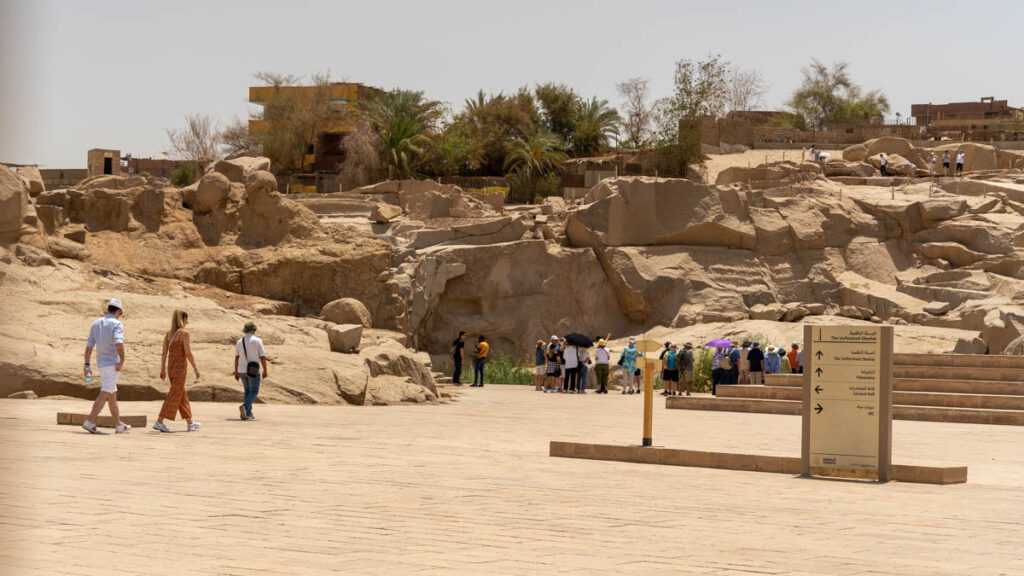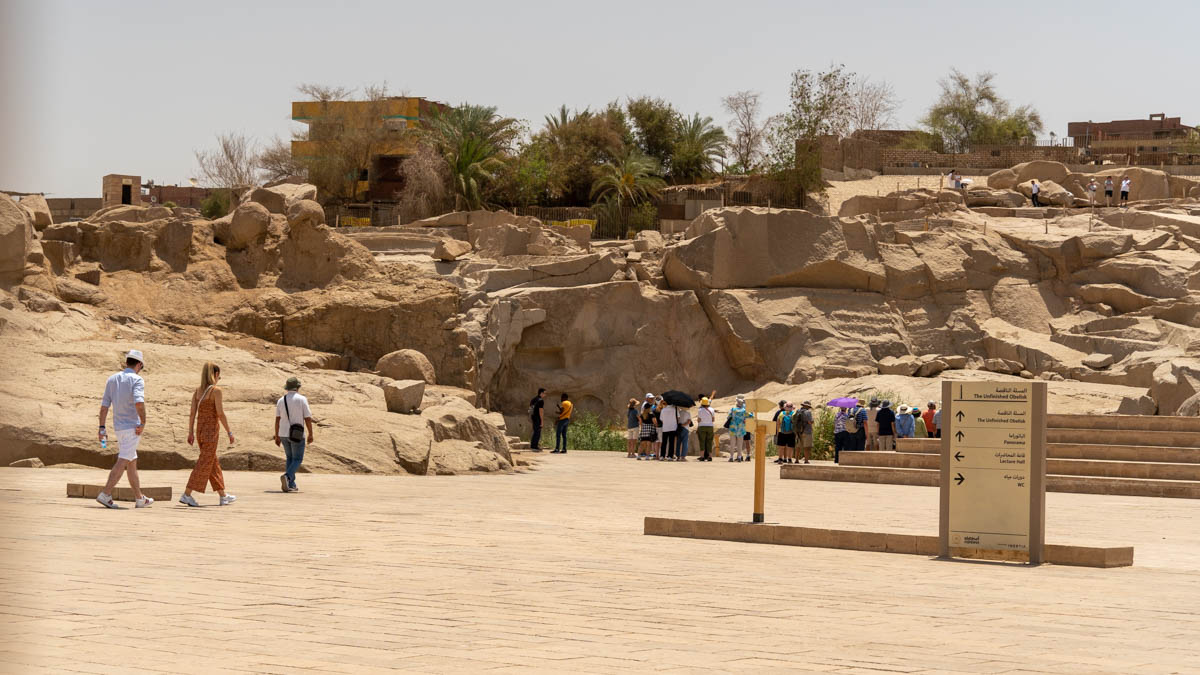Located on an idyllic island in the Nile River near Aswan, Egypt, the Temple of Philae stands as a testament to the rich history and architectural marvels of ancient Egypt. This sacred sanctuary, dedicated to the goddess Isis, offers visitors a captivating journey into the world of ancient Egyptian mythology and religious practices.
- Historical Significance: The Temple of Philae is renowned for its historical significance. The original temple complex was built during the Ptolemaic and Roman eras, with construction spanning several centuries. It served as an important center of worship for the goddess Isis, one of the most revered deities in the ancient Egyptian pantheon.
- Island Setting: What makes the Temple of Philae truly remarkable is its location on an island known as Philae. The island was carefully selected as the site for the temple, providing a tranquil and sacred retreat that was accessible only by boat. Today, visitors can reach the temple via a short boat ride, adding to the sense of enchantment and discovery.
- Architectural Splendor: The Temple of Philae exhibits a stunning blend of Egyptian and Greco-Roman architectural styles. Admire the towering pylons, ornate reliefs, and intricately carved columns that adorn the temple’s structures. The walls depict scenes from ancient Egyptian mythology and rituals, providing a fascinating glimpse into the beliefs and practices of the time.
- The Cult of Isis: Isis, the primary deity worshiped at the Temple of Philae, was revered as the goddess of magic, fertility, and motherhood. The temple served as a major pilgrimage site, attracting devotees from all over the ancient world who sought the blessings and protection of the goddess. It was believed that Isis possessed great healing powers, and her temple became a sanctuary for those seeking spiritual solace and divine intervention.
- Relocation Efforts: In the 20th century, the construction of the Aswan High Dam threatened to submerge the Temple of Philae underwater. To preserve this priceless heritage, an international effort was undertaken to relocate the entire temple complex to a nearby island called Agilkia. The meticulous process of dismantling, relocating, and reconstructing the temple complex ensured its preservation for future generations to admire and appreciate.
- Sound and Light Show: To enhance the visitor experience, the Temple of Philae offers a mesmerizing sound and light show after sunset. Illuminated against the night sky, the temple’s structures come to life as narrators recount the temple’s history, ancient myths, and legends. The show provides a captivating way to immerse oneself in the temple’s enchanting ambiance and further deepen the understanding of its significance.
Conclusion: The Temple of Philae on the island of Philae stands as a captivating testament to the rich religious and architectural heritage of ancient Egypt. Its island setting, architectural splendor, and historical significance make it a must-visit destination for those seeking to delve into the mysteries of the ancient world. A journey to the Temple of Philae is a magical experience that allows visitors to connect with the spiritual beliefs and cultural traditions of ancient Egypt, leaving an indelible impression of wonder and admiration.

The Temple of Philae: A Sacred Island Retreat
Nestled on the serene island of Philae in the Nile River, the Temple of Philae stands as a testament to the grandeur and spiritual significance of ancient Egypt. With its rich history, architectural splendor, and picturesque setting, this sacred sanctuary invites visitors on a captivating journey through time. Join me as we embark on an exploration of the enchanting Temple of Philae.
- Stepping into Ancient Egypt: As you approach the Temple of Philae, you can’t help but feel a sense of awe. The towering pylons, adorned with intricate carvings, transport you to an era of pharaohs and gods. Step through the monumental entrance, and you’ll find yourself immersed in the mystical world of ancient Egypt.
- Architectural Marvels: The Temple of Philae showcases a harmonious blend of Egyptian and Greco-Roman architectural styles. Marvel at the symmetrical columns, each intricately carved with hieroglyphs and decorative motifs. Take in the ornate reliefs that adorn the temple walls, depicting scenes from ancient Egyptian mythology and religious rituals. The attention to detail and craftsmanship are awe-inspiring.
- The Cult of Isis: The Temple of Philae served as a place of worship for the goddess Isis, the divine mother and protector. Explore the various chambers and sanctuaries dedicated to her, and you’ll feel the reverence that ancient Egyptians held for this deity. Discover the rituals and beliefs associated with the goddess, and gain a deeper understanding of the spiritual practices of the time.
- Mysteries and Legends: As you wander through the temple’s corridors, you’ll encounter stories and legends that have been etched into the walls for millennia. From tales of gods and goddesses to accounts of ancient rituals, the reliefs and hieroglyphs offer glimpses into the myths and history of ancient Egypt. Allow your imagination to soar as you decipher the secrets hidden within these ancient symbols.
- Relocation and Preservation: The preservation of the Temple of Philae is a remarkable story in itself. With the construction of the Aswan High Dam, the temple faced the threat of submersion. However, an international effort was undertaken to relocate the entire temple complex to the nearby island of Agilkia. Witnessing the temple’s preservation and restoration is a testament to the dedication and passion for safeguarding our shared human heritage.
- Sunset Splendor: To further immerse yourself in the magical ambiance of the Temple of Philae, consider attending the mesmerizing sound and light show that takes place at dusk. As the sun sets, the temple is illuminated, casting a mystical glow on its ancient structures. Through a captivating narration, the show brings the temple’s history to life, weaving together tales of pharaohs, gods, and the enduring spirit of ancient Egypt.
Conclusion: Visiting the Temple of Philae is a transformative experience that allows us to connect with the wonders of ancient Egypt. As we wander through its sacred halls, we are transported to a time long past, where the gods and goddesses were worshipped, and myths and legends shaped the collective imagination. The Temple of Philae stands as a testament to the human desire to preserve and honor our cultural heritage. So, embark on this journey through time, and let the Temple of Philae awaken your sense of wonder and ignite your curiosity about the mysteries of ancient civilizations.
The importance of the Temple of Philae
The Temple of Philae holds significant historical and cultural importance in Egypt. Located on the island of Philae in the Nile River, it was originally constructed during the Ptolemaic period of ancient Egypt and completed during the Roman era. The temple complex is dedicated to the goddess Isis, who was highly revered in the Egyptian pantheon.
Here are some key reasons why the Temple of Philae is important:
- Religious Significance: The temple was one of the main centers for the worship of the goddess Isis, who was considered a powerful deity associated with fertility, healing, and magic. Isis was also associated with the renewal of life and played a central role in the myth of Osiris and Isis. The temple served as a site of pilgrimage and religious ceremonies, attracting devotees from across the ancient world.
- Architectural Excellence: The Temple of Philae showcases remarkable architectural design and craftsmanship. It features a fusion of Egyptian and Greco-Roman architectural styles, reflecting the influence of different periods in Egypt’s history. The temple’s intricate reliefs, hieroglyphs, and colossal statues display the skill and artistry of the ancient Egyptian builders.
- Relocation and Preservation Efforts: In the 20th century, the construction of the Aswan High Dam threatened to submerge the Temple of Philae underwater permanently due to the rising waters of the Nile. In an international effort, the temple complex was dismantled and relocated to a nearby island, Agilkia, stone by stone. This remarkable feat of engineering preserved the temple and ensured its survival for future generations.
- UNESCO World Heritage Site: The Temple of Philae, along with other Nubian monuments, was inscribed as a UNESCO World Heritage Site in 1979. This recognition highlights its outstanding universal value as a cultural and historical monument. It attracts tourists from around the world, contributing to the local economy and promoting cultural exchange.
- Symbol of Egypt’s Ancient Civilization: The Temple of Philae represents the rich legacy of ancient Egypt and its civilization. It serves as a tangible reminder of the country’s cultural heritage, showcasing the religious beliefs, architectural achievements, and artistic traditions of one of the world’s oldest civilizations. The preservation and study of the temple provide valuable insights into Egypt’s past and contribute to our understanding of human history.
In summary, the Temple of Philae is important for its religious significance, architectural excellence, preservation efforts, UNESCO World Heritage status, and its representation of Egypt’s ancient civilization. It stands as a testament to human ingenuity and the enduring legacy of the ancient Egyptians.

The myth of the Philae Temple
The Temple of Philae itself is not directly associated with a specific myth, but rather dedicated to the goddess Isis, who plays a prominent role in Egyptian mythology. However, there are several myths and legends in Egyptian mythology that involve the goddess Isis and are relevant to the worship and significance of the temple. Here is one of the well-known myths associated with Isis:
The Myth of Osiris and Isis:
The myth revolves around the deities Osiris, Isis, and their brother Set. Osiris was the god of the underworld, fertility, and resurrection, and he ruled as the king of Egypt. Set, driven by jealousy and ambition, plotted against Osiris and killed him, dismembering his body and scattering the pieces across Egypt.
Isis, the wife and sister of Osiris, embarked on a quest to find and reunite the body parts of her husband. With her unwavering devotion and magical abilities, she successfully recovered all the pieces except for one, the phallus, which was swallowed by a fish in the Nile.
Using her powerful magic, Isis reassembled the body of Osiris, transforming into a bird and fanning her wings to breathe new life into him. Osiris then became the lord of the underworld, representing death and rebirth.
Isis and Osiris also conceived a son named Horus, who would later become a central figure in Egyptian mythology as the god of the sky and protector of the pharaohs. Horus sought to avenge his father’s death and engaged in a fierce battle with Set.
Isis, revered as a protective goddess and a symbol of motherhood, played a crucial role in the resurrection and afterlife of Osiris. Her worship spread throughout Egypt, and numerous temples were dedicated to her, including the Temple of Philae.
The Temple of Philae, being dedicated to Isis, served as a sacred space where rituals and ceremonies honoring the goddess were performed. The temple was considered a place of pilgrimage and a focal point for worshipers seeking blessings, healing, and spiritual guidance from Isis.
It’s important to note that Egyptian mythology is rich and complex, and there are variations of myths and different interpretations depending on different time periods and regions. The myth of Osiris and Isis is one of the most widely known and significant, highlighting the themes of life, death, resurrection, and the power of devotion and magic.
Philae Temple was re-location
In the 1960s, the rising waters of the Nile River caused by the construction of the Aswan High Dam posed a threat to several ancient monuments, including the Temple of Philae. To prevent its submersion, an international campaign was launched to salvage and relocate the temple complex.
Between 1972 and 1980, the temple was painstakingly dismantled and moved to a nearby island called Agilkia, located about 550 meters southwest of its original location on the island of Philae. Each stone block was carefully labeled, cataloged, and reassembled on Agilkia, mirroring the temple’s original layout as closely as possible.
The relocation effort aimed to preserve the temple’s architectural and historical significance while also protecting it from the encroaching waters of the Nile. The success of the project ensured that the Temple of Philae remained accessible for study, tourism, and continued reverence.
The relocation of the Temple of Philae stands as a remarkable feat of engineering and international cooperation, preserving an invaluable piece of Egypt’s cultural heritage for future generations.

What is so special about Philae Temple
The Temple of Philae holds several characteristics that make it special and unique among the ancient Egyptian temples:
- Island Location: The Temple of Philae is situated on an island in the Nile River, which adds to its picturesque and tranquil setting. The island itself was considered sacred in ancient times, and its location enhances the spiritual and mystical atmosphere surrounding the temple.
- Goddess Isis Worship: The temple is dedicated to the goddess Isis, one of the most important and revered deities in ancient Egyptian mythology. Isis was associated with various aspects such as motherhood, magic, healing, and protection. The Temple of Philae served as one of the main centers for the worship of Isis, attracting devotees from far and wide.
- Greco-Roman Influence: The architectural style of the Temple of Philae showcases a unique blend of Egyptian and Greco-Roman influences. This fusion is a result of the temple’s construction during the Ptolemaic and Roman periods. The temple features traditional Egyptian elements like pylons, courts, and sanctuaries, along with Greek and Roman architectural motifs, such as columns and friezes, reflecting the cultural exchange and syncretism of the time.
- Intricate Reliefs and Hieroglyphs: The walls of the temple are adorned with intricate carvings, reliefs, and hieroglyphic inscriptions. These elaborate decorations depict scenes from Egyptian mythology, including the myth of Isis and Osiris, rituals, offerings, and historical events. The reliefs provide valuable insights into ancient Egyptian religious beliefs, ceremonies, and daily life.
- Relocation and Preservation: The relocation of the Temple of Philae to Agilkia Island was a remarkable undertaking that ensured its preservation and protection from the rising waters of the Nile due to the Aswan High Dam. This monumental effort demonstrated the global recognition of the temple’s cultural and historical significance and the commitment to safeguarding it for future generations.
- UNESCO World Heritage Site: The Temple of Philae, along with other Nubian monuments, has been designated as a UNESCO World Heritage Site. This prestigious status highlights its outstanding universal value, contributing to the international recognition and appreciation of its historical, architectural, and cultural significance.
The combination of its island location, dedication to the revered goddess Isis, architectural uniqueness, intricate artwork, preservation efforts, and UNESCO recognition collectively contribute to the special and significant nature of the Temple of Philae

